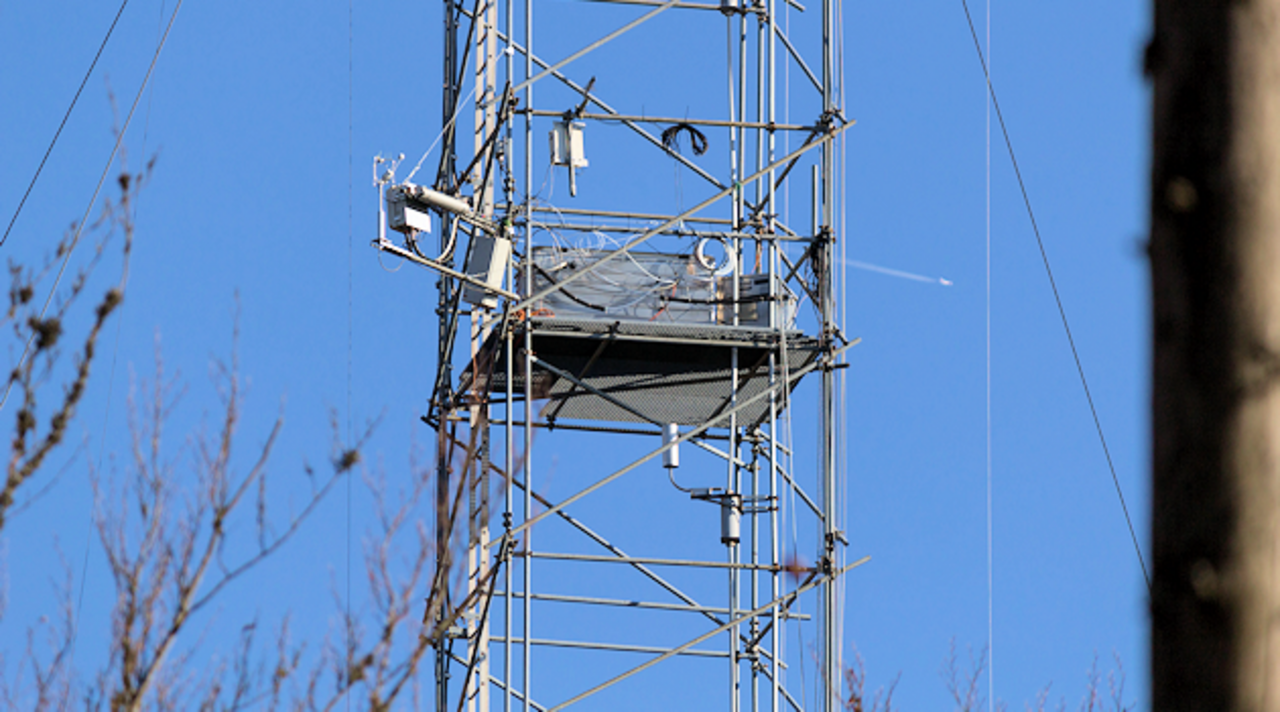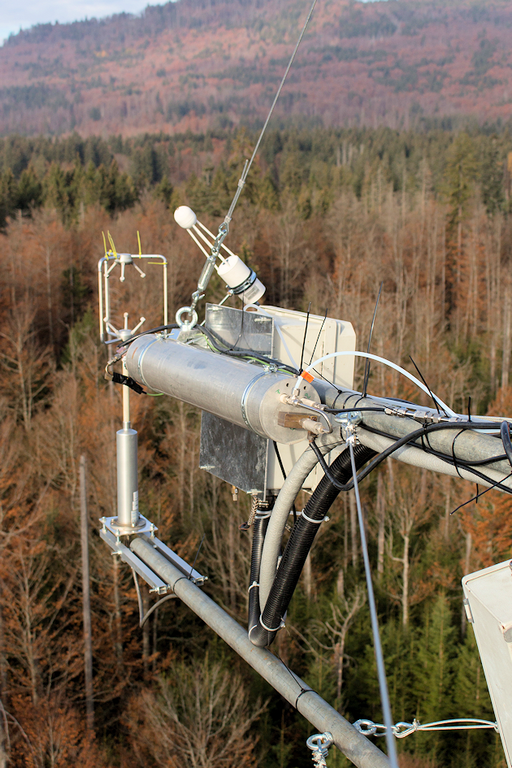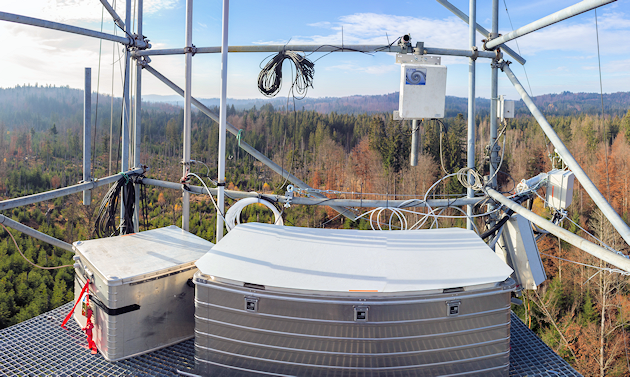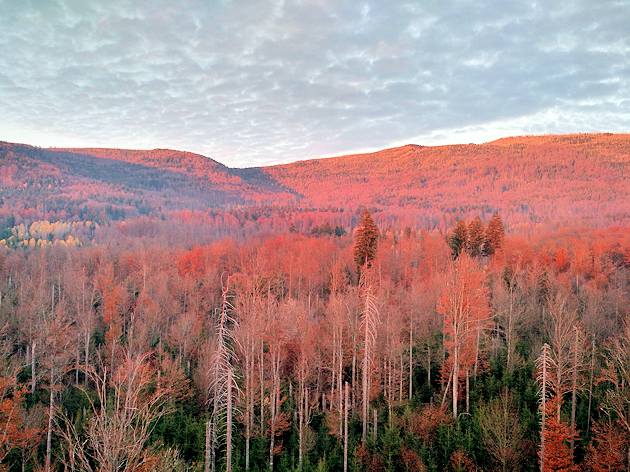Project
FORESTFLUX

FORESTFLUX - Improving assessment tools for political consulting and implementation through local validation of air pollution models
Agriculture in Germany generates more than 90 % of national ammonia emissions. Data for determining emissions, transport and deposition are scarce and highly uncertain.
Background and Objective
Only little knowledge and few measurements exist about accurate quantification of ammonia release, its transport and deposition after fertilizer application. For the generation of more useful data sets, the Thünen Institute of Climate-Smart Agriculture deploys novel measurement techniques for the determination of ammonia and total nitrogen ecosystem-atmosphere exchange fluxes. We conduct continuous eddy-covariance measurements at a representative forest site in the ‘Bavarian Forest’ national park. Concentration and flux data are being used to validate local and regional air pollution models with the aim to reduce existing uncertainties and to derive suitable model input parameters. New findings from combining measurements and modeling will be transferred to evaluate other forest ecosystems. The comparison of results to traditional methods of estimating nitrogen input – such as a canopy balance approach – is a further aim of the study.
Approach
Scientists and technicians from Thünen Institute of Climate-Smart Agriculture and the ‘Bavarian Forest’ national park administration conduct continuous concentration measurements of ammonia and total reactive nitrogen at the ‘Forellenbach’ site and determine exchange fluxes between forest ecosystem and atmosphere. The analysis of biophysical control parameters will be used to improve the understanding of ecosystem functioning. Measurement data will serve as model input and for the derivation of ecosystem-specific parameters. Model output will be used to quantify and to understand the exchange of reactive nitrogen compounds on local, regional and national scale and will help assessing environmental quality objectives.

Results
The TRANC measurements result in an average annual deposition of 4.3 to 4.5 kg N ha-1, 5.2 kg N ha-1 yr-1 from location-based modeling and LOTOS-EUROS with uncorrected land use, and 6.9 kg N ha-1 a-1 from LOTOS-EUROS with corrected land use. In order to improve the understanding of the relationship between meteorology, ecosystem and nitrogen exchange, particularly for creating a better basis for modeling in the future, an analysis of the control factors of the ΣNr fluxes was carried out. Through the use of artificial neural networks in the test period July to September 2016, a strong influence of global radiation, and thus a similarity to the CO2 flux, was identified. The ΣNr concentration was also a decisive factor. Parameters such as air or leaf moisture played an unexpected little role at this location. The measurement setup can be recommended for future studies. Detailed results can be found in the publications listed below.
Thünen-Contact

Involved external Thünen-Partners
- TNO
(Delft, Niederlande)
Funding Body
-
Umweltbundesamt (UBA)
(national, öffentlich)
Duration
10.2015 - 11.2018
More Information
Project funding number: 3715 51 211 0
Project status:
finished
Publications
- 0
Wintjen P, Schrader F, Schaap M, Beudert B, Brümmer C (2022) Forest-atmosphere exchange of reactive nitrogen in a remote region - Part I: Measuring temporal dynamics. Biogeosciences 19(2):389-413, DOI:10.5194/bg-19-389-2022
- 1
Wintjen P, Schrader F, Schaap M, Beudert B, Kranenburg R, Brümmer C (2022) Forest-atmosphere exchange of reactive nitrogen in a remote region - Part II: Modeling annual budgets. Biogeosciences 19(22):5287–5311, DOI:10.5194/bg-19-5287-2022
- 2
Lucas-Moffat AM, Schrader F, Herbst M, Brümmer C (2022) Multiple gap-filling for eddy covariance datasets. Agric Forest Meteorol 325(Okt. 2022):109114, DOI:10.1016/j.agrformet.2022.109114
- 3
Brümmer C, Rüffer J, Delorme J-P, Wintjen P, Schrader F, Beudert B, Schaap M, Ammann C (2022) Reactive nitrogen fluxes over peatland and forest ecosystems using micrometeorological measurement techniques. Earth Syst Sci Data 14(2):743-761, DOI:10.5194/essd-14-743-2022
- 4
Brümmer C, Rüffer J, Delorme J-P, Wintjen P, Schrader F, Beudert B, Schaap M, Ammann C (2021) Reactive nitrogen fluxes over peatland (Bourtanger Moor) and forest (Bavarian Forest National Park) using micrometeorological measurement techniques, [Data set, Version 1.0] [Datenpublikation] [online]. 13 Dateien. Genève: Zenodo, zu finden in <https://zenodo.org/record/5841074#.YekbfOcxk2w> [zitiert am 20.01.2022], DOI:10.5281/zenodo.5841074
- 5
Wintjen P, Ammann C, Schrader F, Brümmer C (2020) Correcting high-frequency losses of reactive nitrogen flux measurements. Atmos Measurem Techniques 13(6):2923-2948, DOI:10.5194/amt-13-2923-2020
- 6
Brümmer C, Schrader F, Wintjen P, Zöll U, Schaap M (2020) FORESTFLUX - Standörtliche Validierung der Hintergrunddeposition reaktiver Stickstoffverbindungen : Abschlussbericht [online]. Dessau: Umweltbundesamt, 72 p, Texte UBA 40, zu finden in <https://www.umweltbundesamt.de/publikationen/forestflux-standoertliche-validierung-der> [zitiert am 05.03.2020]
- 7
Zöll U, Lucas-Moffat AM, Wintjen P, Schrader F, Beudert B, Brümmer C (2019) Is the biosphere-atmosphere exchange of total reactive nitrogen above forest driven by the same factors as carbon dioxide? An analysis using artificial neural networks. Atmos Environ 206:108-118, DOI:10.1016/j.atmosenv.2019.02.042
- 8
Schrader F, Schaap M, Zöll U, Kranenburg R, Brümmer C (2018) The hidden cost of using low-resolution concentration data in the estimation of NH3 dry deposition fluxes. Sci Rep 8:969, DOI:10.1038/s41598-017-18021-6

![[Translate to English:] [Translate to English:]](/media/_processed_/6/4/csm_titel_CO2Kampagne8_afeea2273e.png)
![[Translate to English:] [Translate to English:]](/media/_processed_/4/1/csm_titel_93px_CO2Kampagne8_9b0f3354d4.png)








